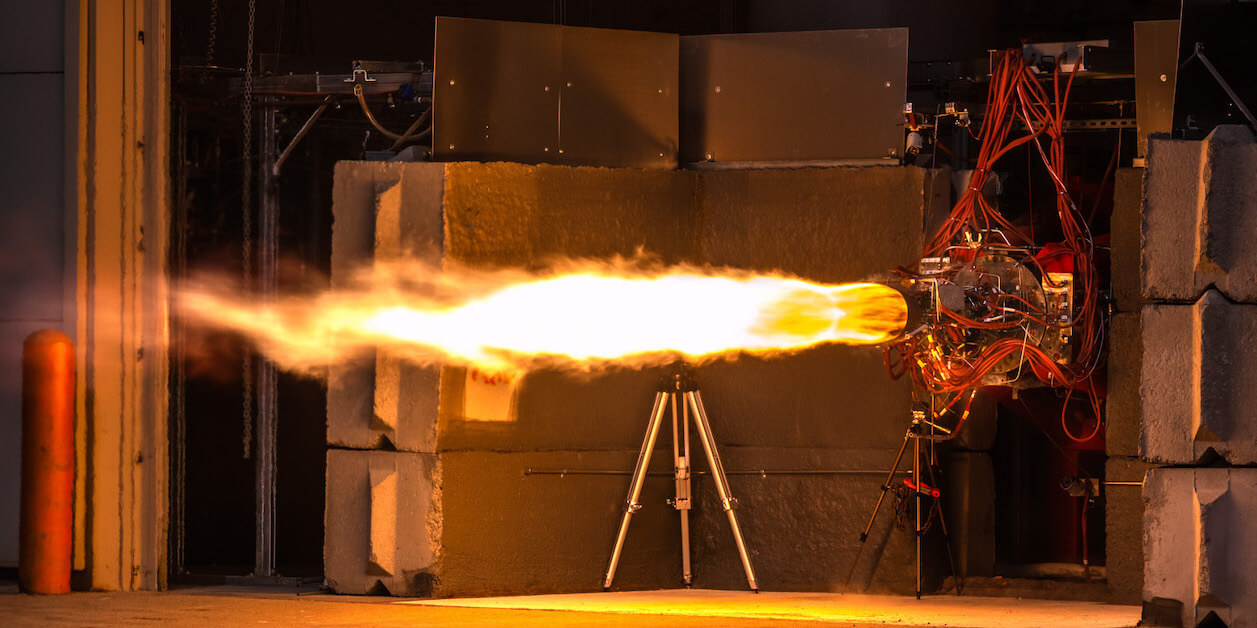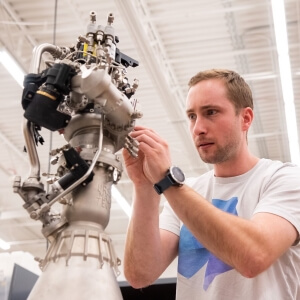
At Ursa Major Technologies, all of the rocket engines the team designs are tested in-house at their Colorado facility
Under a cloud-streaked sky on a wide-open plain, a rocket engine ignites. Its tail of molten orange spikes out of the back of an unassuming warehouse-like building framed against snowcapped Rocky Mountain peaks.
The engine isn’t going anywhere — at least not right now. It’s bolted to a stand for a full-duration test that simulates the mission it’s headed for. The engineers push the engine to the bounds of its operating capabilities as it burns hot and bright, generating enough propulsion to reach hypersonic speeds, launch a vehicle into space, or set an in-space craft on a precise trajectory.
Welcome to a typical day at Ursa Major Technologies, a rocket-propulsion company in Berthoud, Colorado, founded in 2015 by USC Viterbi alumnus Joe Laurienti, B.S. ’11. The Ursa Major team — which includes a total of 13 USC alumni — designs and manufactures reusable staged-combustion engines that are versatile enough to propel any of the missions noted above.

Ursa Major Technologies’ founder, Joe Laurienti, sees propulsion innovation as critical to growing the commercial space industry
Laurienti’s aim in founding the company was to decrease some of the financial and logistical barriers to accessing space, thereby helping to grow the burgeoning commercial space industry. Ursa Major’s engines are over 80 percent 3D printed by mass, which lowers typical manufacturing costs and yields engines that are affordable by industry standards.
“We’re making it so that companies can get to space for the first time by themselves,” says Laurienti — without having to rely on current spaceflight dominators like SpaceX and Blue Origin.
After years of refinement, the “Hadley” engine (which, at 5,000 pounds of thrust, is the smallest of three engines Ursa Major is currently producing) will debut on a trio of missions in 2023, including Stratolaunch’s Talon-A hypersonic testbed.
Ursa Major’s engines, which incorporate the company’s novel material alloys, are “designed to be higher performing in more settings than anything else in history,” says Laurienti. “Never before has a single engine been used on three very different missions in one year.”
Yet if it hadn’t been for Laurienti’s involvement in the USC Rocket Propulsion Lab (RPL) as an undergraduate, his history-making company may never have gotten off the ground.
Preparing for liftoff
Laurienti grew up in the northern Colorado area where Ursa Major is headquartered. He’s the son of a USC-trained mechanical engineer who spent his career working on satellites.
Watching satellite launches with his dad as a kid, Laurienti knew that “the [satellite] that was going to space, that was on top of the rocket, was really important,” he says. “But the fire coming out of the bottom was way more fun.”
During college, Laurienti’s interest in propulsion led him to join RPL. The group’s goal during Laurienti’s undergraduate years was to launch the first student-designed and student-built rocket into space. (They achieved this in 2019, after Laurienti graduated, with the Traveler IV rocket).
In RPL, Laurienti gained propulsion know-how and met likeminded peers, including fellow aerospace engineering major Bill Murray, B.S. ’12. After graduation, both Laurienti and Murray went on to work on propulsion systems at SpaceX and Blue Origin.
“That extreme hands-on experience [in RPL] … was what got us in the door,” says Laurienti. “They needed engineers that could [not only] design parts but also build and test parts.”

Bill Murray oversees the engines’ design from development through production
Murray notes that Laurienti talked about wanting to start his own company as far back as their RPL days. “So when he did come [to me] with a business proposal, I wasn’t surprised,” says Murray, who joined Ursa Major at the outset and is now the vice president of engineering. “He and I both had that kind of drive to go try something new on our own.”
The sky’s the limit
Laurienti’s stints at SpaceX and Blue Origin showed him that the next wave of growth in the commercial space industry would involve specialization. He decided to focus his business on engines as a way to advance the entire industry because, when it comes to spaceflight, “propulsion is the barrier to entry, by far the biggest risk, [and] also the performance dominator,” he says. “Propulsion dictates how much satellite you get to orbit or how capable a hypersonic aircraft is.”
In addition to supplying engines to commercial clients, Ursa Major also has projects underway with the U.S. Air Force and Space Force. Laurienti sees propulsion innovation as critical to forward-looking endeavors such as increasing communication from low Earth orbit, growing the cislunar economy, mining the asteroid belt and accelerating interplanetary travel.
“We’re excited about someday making Mars not a six-month trip, like it would be today, but maybe a six-week trip using some really advanced propulsion,” says Laurienti.
Closer to home, he hopes that another beneficiary of Ursa Major’s technology will be university students. Helping student groups like RPL do experiments on orbit would be another way for Laurienti to democratize access to space — and to pay his gratitude forward.
Of himself and the other USC RPL alums working at Ursa Major, Laurienti says, “We wouldn’t be where we are in our careers without RPL.”
Published on February 15th, 2023
Last updated on February 15th, 2023







